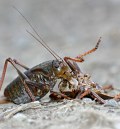 Hunger for protein and salt, and a fear of cannibalism, drives the
Hunger for protein and salt, and a fear of cannibalism, drives the
mass migration of Mormon crickets across western North America, says Stephen Simpson of the University of Sydney, Australia. Mormon cricket swarms, sometimes millions strong covering more than 50 miles in a season. They destroy vegetation in their path and are a severe hazard to drivers.
Locust plagues of Biblical proportions have been with mankind, since, well, Biblical times, at least(!) and usually these creatures swarm in response to a shortage of food. The precise nutritional triggers for the migrations of Mormon crickets though have remained a mystery. Now, field observations by Simpson and his colleagues offer an explanation.
It seems that total starvation is not the driving force, rather migratory crickets preferentially feed at experimental protein-rich and salt rich sources. In the field, crickets were frequently observed feeding on carrion and on each other. When the movement of crickets was experimentally impaired (immobilized by gluing and/or tethering), these insects became targets for cannibalism by neighbouring crickets. These results thus reveal a different model for collective motion, with the crickets’ migration in effect a forced march, the researchers say. The constant threat of cannibalism from the rear appears to push the crickets’ movement as much as the need to find protein and salt pulls it.
Simpson and his colleagues publish further details of their findings today in the online edition of PNAS.